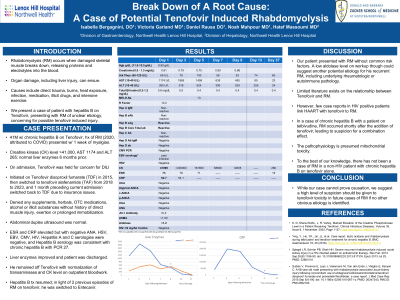Monday Poster Session
Category: Liver
P2464 - Break Down of a Root Cause: A Case of Potential Tenofovir Induced Rhabdomyolysis
Monday, October 23, 2023
10:30 AM - 4:15 PM PT
Location: Exhibit Hall

Has Audio

Isabella Bergagnini, DO
Lenox Hill Hospital, Northwell Health
New York, NY
Presenting Author(s)
Isabella Bergagnini, DO, Victoria Garland, MD, Daniel Rausa, DO, Noah Mahpour, MD, Hatef Massoumi, MD
Lenox Hill Hospital, Northwell Health, New York, NY
Introduction: Rhabdomyolysis (RM) occurs when damaged skeletal muscle breaks down, releasing proteins and electrolytes into the blood. Organ damage, including liver injury, can ensue. Causes include direct trauma, burns, heat exposure, infection, medication, illicit drugs, and intensive exercise. We present a case of a patient with hepatitis B on Tenofovir, presenting with RM of unclear etiology, concerning for possible tenofovir induced injury.
Case Description/Methods: A 41-year-old man with Chronic Hepatitis B on Tenofovir, history of RM in 2020 (attributed to COVID) presented with one week of myalgias. Creatine Kinase (CK) level >41,000 with AST 1174 and ALT 265, and normal liver enzymes 6 months prior. On admission, Tenofovir was held for concern for drug related liver injury. He was initiated on Tenofovir disoproxil fumarate (TDF) in 2015, then switched to tenofovir alafenamide (TAF) from 2018 to 2023, and 1 month preceding current admission switched back to TDF due to insurance issues. His only other home medication was pantoprazole. He denied taking any supplements, herbals, over the counter medications, alcohol or illicit substances without history of direct muscle injury, exertion, or prolonged immobilization. Abdominal duplex ultrasound was normal. ESR and CRP were elevated but with negative ANA. HSV, EBV, CMV, HIV, Hepatitis A and C serologies were negative, and Hepatitis B serology was consistent with chronic hepatitis B with PCR 27. Liver enzymes improved, and patient was discharged. He remained off Tenofovir with normalization of transaminases and CK level on outpatient bloodwork. Hepatitis B treatment was resumed; however, in light of two previous episodes of RM on tenofovir, he was switched to Entecavir.
Discussion: Our patient presented with RM without common risk factors and an unrevealing workup. Limited literature exists on the relationship between Tenofovir and RM. However, few case reports in HIV positive patients link HAART with tenofovir to RM. In a case of chronic hepatitis B with a patient on telbivudine, RM occurred shortly after the addition of tenofovir, leading to suspicion for a combination effect. The pathophysiology is presumed mitochondrial toxicity. To the best of our knowledge, there has not been a case of RM in a non-HIV patient with chronic hepatitis B on tenofovir alone. While our case cannot prove causation, we suggest a high level of suspicion should be given to tenofovir toxicity in future cases of RM if no other obvious etiology is identified.
Disclosures:
Isabella Bergagnini, DO, Victoria Garland, MD, Daniel Rausa, DO, Noah Mahpour, MD, Hatef Massoumi, MD. P2464 - Break Down of a Root Cause: A Case of Potential Tenofovir Induced Rhabdomyolysis, ACG 2023 Annual Scientific Meeting Abstracts. Vancouver, BC, Canada: American College of Gastroenterology.
Lenox Hill Hospital, Northwell Health, New York, NY
Introduction: Rhabdomyolysis (RM) occurs when damaged skeletal muscle breaks down, releasing proteins and electrolytes into the blood. Organ damage, including liver injury, can ensue. Causes include direct trauma, burns, heat exposure, infection, medication, illicit drugs, and intensive exercise. We present a case of a patient with hepatitis B on Tenofovir, presenting with RM of unclear etiology, concerning for possible tenofovir induced injury.
Case Description/Methods: A 41-year-old man with Chronic Hepatitis B on Tenofovir, history of RM in 2020 (attributed to COVID) presented with one week of myalgias. Creatine Kinase (CK) level >41,000 with AST 1174 and ALT 265, and normal liver enzymes 6 months prior. On admission, Tenofovir was held for concern for drug related liver injury. He was initiated on Tenofovir disoproxil fumarate (TDF) in 2015, then switched to tenofovir alafenamide (TAF) from 2018 to 2023, and 1 month preceding current admission switched back to TDF due to insurance issues. His only other home medication was pantoprazole. He denied taking any supplements, herbals, over the counter medications, alcohol or illicit substances without history of direct muscle injury, exertion, or prolonged immobilization. Abdominal duplex ultrasound was normal. ESR and CRP were elevated but with negative ANA. HSV, EBV, CMV, HIV, Hepatitis A and C serologies were negative, and Hepatitis B serology was consistent with chronic hepatitis B with PCR 27. Liver enzymes improved, and patient was discharged. He remained off Tenofovir with normalization of transaminases and CK level on outpatient bloodwork. Hepatitis B treatment was resumed; however, in light of two previous episodes of RM on tenofovir, he was switched to Entecavir.
Discussion: Our patient presented with RM without common risk factors and an unrevealing workup. Limited literature exists on the relationship between Tenofovir and RM. However, few case reports in HIV positive patients link HAART with tenofovir to RM. In a case of chronic hepatitis B with a patient on telbivudine, RM occurred shortly after the addition of tenofovir, leading to suspicion for a combination effect. The pathophysiology is presumed mitochondrial toxicity. To the best of our knowledge, there has not been a case of RM in a non-HIV patient with chronic hepatitis B on tenofovir alone. While our case cannot prove causation, we suggest a high level of suspicion should be given to tenofovir toxicity in future cases of RM if no other obvious etiology is identified.
Disclosures:
Isabella Bergagnini indicated no relevant financial relationships.
Victoria Garland indicated no relevant financial relationships.
Daniel Rausa indicated no relevant financial relationships.
Noah Mahpour indicated no relevant financial relationships.
Hatef Massoumi indicated no relevant financial relationships.
Isabella Bergagnini, DO, Victoria Garland, MD, Daniel Rausa, DO, Noah Mahpour, MD, Hatef Massoumi, MD. P2464 - Break Down of a Root Cause: A Case of Potential Tenofovir Induced Rhabdomyolysis, ACG 2023 Annual Scientific Meeting Abstracts. Vancouver, BC, Canada: American College of Gastroenterology.
